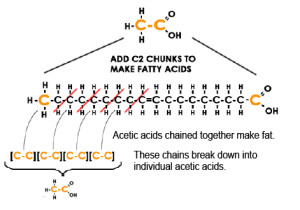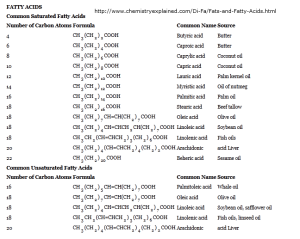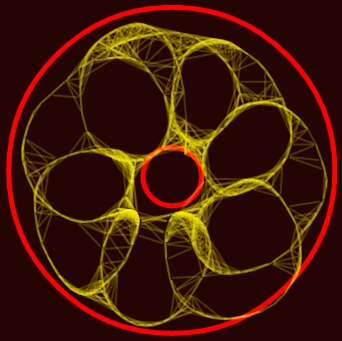Life in the Cell Begins at the Edge of Death, Part 8
Part 8: Fat (not glucose) is the Main Fuel for the Body.
or Fat is the Primary Source of Acetic Acid.
Look below how I split acetic acid in half.
Each end constructs the end pieces of the ‘carbon backbone’ molecule below.
 This larger, commonly eaten food molecule is called oleic acid. It is the primary component of quality olive oil. It is made out of 9 acetic acids attached together – making a total of 18 carbon atoms.
This larger, commonly eaten food molecule is called oleic acid. It is the primary component of quality olive oil. It is made out of 9 acetic acids attached together – making a total of 18 carbon atoms.
As shown by the red slashes, oleic acid breaks down neatly and directly the same way it was put together – namely, into individual acetic acid molecules.
Right now, your cells are breaking fat into acetic acid – but burning it as fast as it’s produced.
So, acetic acid is the master acid used to make all fatty acids. Just adding or subtracting by 2 is the key to deeply comprehend the individual characteristics of fats and oils.
For now, all I want you to see is:
- Acetic acid makes all the fat in the plant and animal world – and vice versa…
- Fat breaks down and then simply burns as the only fuel – acetic acid.
Note: I only showed you how fatty acids breakdown into acetic acid – because it is direct and simple. Carbohydrates do not breakdown directly – that’s why we’ll look at how that works separately.
Main points:
- The actual carbon fuel is acetic acid.
- Fatty acids, not carbs or glucose, supply most of the acetic burned.
- Fatty acids are made by attaching acetic acids together in a ‘carbon backbone’ chain.
 This chart (click to enlarge) lists the common fatty acids up to 20 carbon atoms long. Notice the left column counts by two going down – starting with acetic acid plus one acetic acid. Since each acetic acid contains 2 carbon atoms we get:
This chart (click to enlarge) lists the common fatty acids up to 20 carbon atoms long. Notice the left column counts by two going down – starting with acetic acid plus one acetic acid. Since each acetic acid contains 2 carbon atoms we get:
2+2 = 4. This makes butyric acid, found in butter and all dairy fat.
2+2+2+2+2=10. This makes ‘C10’ or capric acid – the main fatty acid of coconut oil.
The length of fatty acids – e.g. 2, 4, 6, 8, 10… carbon atoms – explains (in lecture by me) why fats and oils like butter and coconut oil added to ‘bullet proof’ coffee and the alcohol in a shot of whiskey all ‘go to the head’ very quickly, among various other fascinating health benefits and macabre stories!
All ‘whole food fat’ is made from a variety of fatty acids. Fatty acids make whole fats or oils are like letters make words.
Next and lastly, Part IX: Coming Full Circle
Part 9: Coming Full Circle
Think again about the concepts:
- ‘life within the cell begin at the edge of death’
- ‘life itself is sustained by endless reversal of continuous molecular breakdown – aerobically powered by acetic acid burning within your body‘.
The take home message is this: all short chain carbon fuels – made from 4 to 12 carbon atom chains – provide ‘instant energy’ for the living. Instant energy is acetic acid. The moment acetic acid is produced… POOF! It disappears and goes up in smoke. This is why you may have heard “coconut oil helps people’s metabolism”; the stuff just breaks down quickly and burns, and there is nothing mysterious about it.
I haven’t told you a thing about long chain fats yet (14 carbon atoms or longer chained fatty acids) – other than right now: they do not easily breakdown into fuel. I only mention this now because this explains why, after death, the human body decomposes breaks down into mostly long chained fatty acids – and we see virtually no short chained fats.
What’s next, going forward
Carbohydrates and glucose do not break down directly or easily into acetic acid like fatty acids do. Carbohydrates or glucose need bacteria to split their ‘carbon atom backbones’ into smaller carbon chunk molecules, which may or may not result in acetic acid.
Next and Lastly, Part 9: Coming Full Circle
END OF THIS LECTURE

